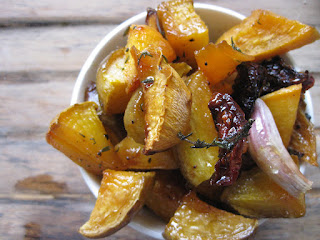We made these fresh, filled 'lunette' for Rosie and Jim's on Sunday and they went down a treat.
The wild garlic filling makes a vivid, pea green centre for the ravioli, splashing colour onto the plate when you cut through, like the perfect poached egg.
Substitute the filling with fresh garlic and peppery rocket or artichoke hearts and fennel seed.
Serve as a light starter for a springtime lunch.
WILD GARLIC AND RICOTTA RAVIOLI
serves 4 and 20
PASTA
FOR 4 FOR 20
400g 00 flour 1kg 00 flour
pinch salt heavy pinch salt
4 free range eggs 10 free range eggs
(roughly one egg per 100g flour)
FILLING
FOR 4 FOR 20
1 bunch wild garlic, stems removed, flowers set aside 3 bunches wild garlic
200g ricotta 600g ricotta
50g Parmesan, grated 200g Parmesan, grated
pinch nutmeg 1 tsp nutmeg
salt and pepper to taste
BUTTER
FOR 4 FOR 20
200g butter 500g butter
1/2 bunch sage, finely chopped, stems removed 1 1/2 bunch sage
1 garlic clove
Pour the flour and salt into a large mixing bowl and make a well in the centre. Add the eggs to the well and beat evenly with a fork, gently incorporating the flour. When the mixture starts to form a more solid shape, use your hands, mixing in the flour until the dough loses most of its stick.
Flour a table and take the dough from the bowl. Knead the dough for about 4 minutes until smooth, elastic, and silky. Wrap in clingfilm and place in the fridge to rest for up to 2 hours.
Bring a pan of water to the boil and throw in the wild garlic. Blanch for 1 minute, drain, and refresh under cold water. When cooled, squeeze the garlic to remove excess water.
Place the garlic with the ricotta into a food processor and blitz until smooth. Add the Parmesan, nutmeg, and a generous helping of salt and pepper. Cover, and place in the fridge to firm up.
Lay a tray with floured baking parchment ready for the ravioli.
Remove the pasta dough from the fridge and cut into bits roughly the size of the palm of your hand. If using a pasta machine (recommended) set to 1 and feed the dough through. Fold three times and feed through again.
Set the machine to two and repeat.
Now set the machine to 5 and feed through once. If making by hand, roll to roughly 2 mm thick. This will be thin enough to give you a light but firm enough ravioli.
Cut the dough with a 3 inch round cutter, making two leaves for each raviolo.
Take the filling from the fridge. Fill the centre of one leaf of pasta with a tsp of the wild garlic. Place another leaf on top and press around the outside with your fingers so the dough sticks together. Making sure each side of the raviolo has been lightly floured, place on the baking sheet. Repeat with the rest of the pasta and filling.
Once made, the ravioli can be covered and put back the fridge until ready to use.
Meanwhile, melt the butter in a pan, adding the garlic clove. Skim off any white froth and curd from the top, remove the garlic and add the chopped sage and salt.
When ready to serve, heat up the butter, and bring a large pan or two of salted water to the boil. Gently drop in the ravioli. When they float to the top, scoop out with a slotted spoon and place into bowls.
Serve with the sage butter, the wild garlic flowers and a pinch of sea salt flakes.
- Too much pasta? Roll it up into a ball and freeze for another lunch -


































